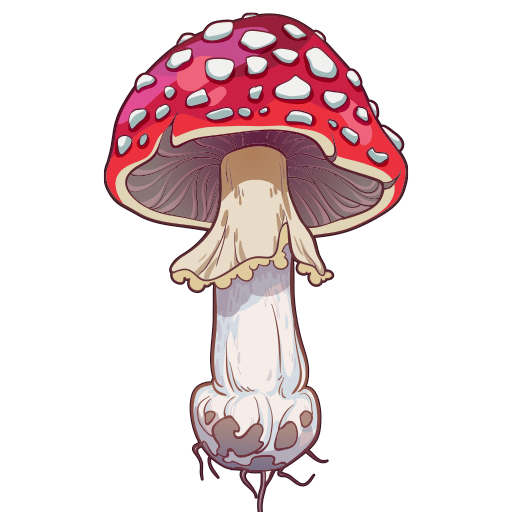3-minute read
Please review this page thoroughly before departing for your mushroom foray or tour, and share it with others in your group as well.
What to expect on a standard mushroom tour
Our mushroom tours and forays are typically in National Forest land and involve your host along with 5-10 guests. You will learn about mushrooms in their natural habitat, meaning you should expect to walk both on- and off-trail. After a brief introduction, the group will typically walk together to a starting point, disperse to look for mushrooms around a specific area for a set amount of time (~15-30 minutes), then gather together to share and learn about what we found before heading to another location.
It is very difficult to predict where and when to find large quantities of choice edible mushrooms. Therefore, it is uncommon for our tours to be held in heavily fruiting areas of chanterelles or other choice edibles. Instead, we prioritize forest areas that are good for groups, relatively accessible, and that provide guests with a chance to learn the characteristics of a forest that are typically good for finding mushrooms (for example, the presence of certain tree species, soil type, or terrain). We also try to bring guests to new spots regularly so that we don’t overuse any one area. This means that while your host will have familiarity with the area, they will not know exactly what you will find that day.
All experienced foragers have days where they find very few mushrooms. The best way to find more interesting mushrooms is to find more mushrooms interesting! Many mushrooms we will come across are not edible, but all have characteristics that we can learn about and enjoy.
What you need to know in advance
Before departing for your tour, please review the information below in detail and ensure you arrive with everything you need to be safe, comfortable, and have fun.
Physical Activity – We might only walk 1-2 miles throughout a 2-3 hour tour. Most of our effort is spent walking off of the trail, crouching to see what’s growing at our feet, stepping over logs, and wading through ferns and other shrubs.
Pets – Our permits with the forest service specifically prohibit pets. Most of the time pets are allowed in the national forest but they are not allowed with commercial group tours like these.
Be On Time – You will typically meet your host at a location that is easy to find and then drive a short distance to our foraging spot. To be respectful to the rest of the group we will only wait at our meeting location for 10 minutes after the agreed-upon meeting time before departing.
Target Shooting – Hunting and target shooting is allowed in many areas of the national forests. We do not pick mushrooms in hunting areas and we plan to keep our distance from areas designated safe for target shooting. That said, we may pass near these areas while en route or encounter noise that can be startling.
Inherent Risks – Engaging in activities in the forest and eating wild mushrooms, even commonly foraged species, carries risk. Please remember that you are responsible for your safety. You will asked to sign an acknowledgment of this before your tour.
Communications and Mobile Coverage – Mobile service is limited in most areas where our tours are held, and you might not have coverage en route or at the meeting location. Please be sure to have Salish Sea Mushrooms’ contact information, a charged mobile device, and maps cached for offline viewing. Here are instructions for how to save Google Maps to your mobile device.
Parking / Foraging Permits – Most tours are hosted from trailheads that require a recreation permit for parking, typically the Northwest Forest Pass which can be purchased for as little as $5 for a one-day use. Information on passes on how to purchase them can be found here. Each forest district also has its policies regarding foraging permits, which might be required to pick mushrooms and take them home. These policies change over time and the most up-to-date information will be on the Forest Service website. I have included a summary of the areas where most of our tours take place below.
Toilets – Many of our meeting spots have pit toilets but not all of them. Pack TP and hand sanitizer as these toilets will occasionally be unstocked, locked, or vandalized. Ladies, consider packing TP or a cloth and peeing in the forest when needed. Kula Cloth is a reusable, antimicrobial cloth that many women use for peeing in the forest. This method isn’t for everyone. Please ask if you have questions about toilet availability.
Mount Baker – Snoqualmie National Forest
Darrington Ranger District (free permit may be required)
(360) 436-1155
Skykomish Ranger District (permit not currently required)
(360) 677-2414
Snoqualmie Ranger District (permit not currently required)
(425) 888-1421
https://www.fs.usda.gov/contactus/mbs/about-forest/contactus
Gifford Pinchot National Forest
https://www.fs.usda.gov/alerts/giffordpinchot/alerts-notices/?aid=73049
Cowlitz Valley Ranger District
(360) 497-1100
Hours: M-F, 8am-4pm (Closed for lunch from 12:15pm-1pm)
What to bring with you
When venturing into the forest in search of mushrooms, you must take responsibility for your safety. The most important items to consider are temperature, precipitation, navigating without mobile service, walking on uneven terrain, and getting to/from the location safely.
The post linked below includes more specifics on things to consider bringing with you, but you should tailor this based on the weather, length of the trip, and your personal preferences and health.
At a minimum you should have the following:
- weather-appropriate clothing and footwear
- charged phone with directions to your location downloaded
- snacks & water
- appropriate permits
